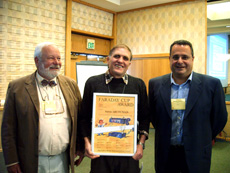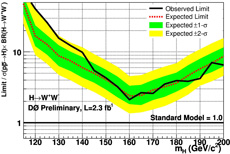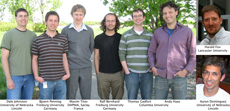|
Thursday, May 22
11 a.m.
Special Accelerator Physics and Technology Seminar - Curia II (NOTE TIME & LOCATION)
Speaker: A. Poklonskiy, Michigan State University
Title: Evolutionary Optimization Methods for Accelerator Design
1 p.m.
Physics and Detector Seminar - West Wing WH-10NW
Speaker: K. Moffeit, Stanford Linear Accelerator Center
Title: Report on Workshop on Polarized Positrons for Linear Colliders (Posipol 2008)
3:30 p.m.
DIRECTOR'S COFFEE BREAK - 2nd Flr X-Over
4 p.m.
Accelerator Physics and Technology Seminar - One West
Speaker: M. Conde, Argonne National Laboratory
Title: High Gradients and RF Power Generation at the Argonne Wakefield Accelerator Facility
Friday, May 23
3:30 p.m.
DIRECTOR'S COFFEE BREAK - 2nd Flr X-Over
4 p.m.
Joint Experimental-Theoretical Physics Seminar - One West
Speaker: P. Jonsson, Imperial College
Title: Searches for MSSM Higgs Bosons with DZero
5-7 p.m.
Art Gallery Reception - Art Gallery
Exhibit Title: Earth Works: Gary Schirmer and Philip Schroeder
Click here for NALCAL,
a weekly calendar with links to additional information.
|
|
Thursday, May 22
- Santa Fe black bean
- Sloppy Joe
- Chicken cordon blue
- Smart cuisine: Spinach enchiladas
- Baked ham & Swiss on a Ciabatta roll
- Assorted slice pizza
- Crispy fried chicken ranch salad
*Carb restricted alternative
Wilson Hall Cafe menu |
|
Thursday, May 22
Dinner
- Cabbage & bacon calzone
- Caesar salad
- Espresso mousse
Wednesday, May 28
Lunch
- Asian grilled beef salad
- Coconut cake
Chez Leon menu
Call x4598 to make your reservation. |
|
|
All-hands meetings Friday (Note new time)
Fermilab Director Pier Oddone will hold all-hands meetings on Friday, May
23, in Ramsey Auditorium. Oddone will meet with employees from the
Accelerator Division, Technical Division, Accelerator Physics Center,
Facilities Engineering Section, Finance Section and Directorate at 11:30 a.m.;
and with employees from the Particle Physics Division, Computing Division, CMS Center,
Work Force Development Section, Business Services Section, ES&H Section, and
Center for Particle Astrophysics at 1 p.m. The sessions will be videotaped
and posted to the Fermilab Web site after the meetings.
|
Faraday Cup Award given for wire sensor technology

From left to right: Julien Bergoz, award sponsor, Suren
Arutunian, award recipient, and Fernando Sannibale, BIW08 chairman.
Historically, beam instrumentation stays in the shadows if an accelerator functions well.
But with the new generation of machines using charged particle beams at power intensities never seen before, the spotlight is shifting toward those who work behind the scenes to control beams.
"At the LHC, this is the first time where a beam could rip a machine apart in one pulse. And many future accelerators will be like this," said AD's Ralph Pasquinelli, a member of the program committee for the international Beam Instrumentation Workshop.
The workshop provides a forum to compare and discuss instrumentation techniques for measuring charged particle beams in accelerators. At the bi-annual workshop, the Faraday Cup Award is given to the innovator of newest and best idea in beam instrumentation technology that goes beyond theory with proven functionality in an accelerator.
This year, the award went to Suren Arutunian, of the Yerevan Physics Institute in Armenia, for designing vibrating wire sensors (VWS) to measure a beam halo. Essentially, the wire's extreme sensitivity to temperature variations causes its vibration frequency to change with varying amounts of intercepted beam. This ability to measure beam halos could have widespread potential in accelerators of the future.
"His particular entry was a novel approach, and the hardware is not too complicated so it's cost effective," Pasquinelli said.
VWS technology works with a wide variety of accelerator diagnostic applications for electron, proton, ion and photon beam monitoring. First experiments for its use with hard X-ray beams in vacuum and air have been promising. Projects in Armenia and APS at Argonne use the technology, which has long-term stability, high precision and resolution.
View previous Faraday Cup Award winners here.
Learn about VWS here and here.
-- Tona Kunz
|
Gardeners wanted
The Fermilab Natural Areas group will
sponsor a volunteer planting event Thursday, May 22, from 3:30 until 6 p.m. Join Roads and Grounds staff along the south shore of Swan Lake. The live plants will help to create a more natural shoreline that will resist erosion and provide texture and color. Volunteers should wear boots and prepare to plant in wet and sloppy conditions. For more information call Roads and Grounds at x3303.
|
Bike commuters spread the word
WBBM news radio interviewed Fermilab Bicycle Commuters Dave Peterson, Jim
Budlong and Dave McGinnis about how the 100-member group started as an
outgrowth of a DOE fuel conservation effort, how they save $1,000 to $1,500
a year in gasoline and vehicle maintenance and what it's like to find a
safe route to work in the congested suburbs. Listen to the full 15-minute
interview.
|
Bottling the big bang
From the Engineer Online, May 19, 2008
The air of anticipation around CERN, the European Organisation for Nuclear Research near Geneva, is palpable. In a matter of weeks, the world's most powerful particle accelerator, the Large Hadron Collider (LHC), will start operating, hurling subatomic particles around its 27km circumference at almost the speed of light. Two months later, the two contra-rotating beams will be squeezed, focused and aimed at each other to collide with colossal force, creating conditions that existed millionths of a second after the Big Bang.
The physics goals of the LHC are mind-boggling. Discovering the Higgs boson, the particle that explains the origins of mass; explaining why the universe is made of matter not anti-matter; freeing the constituent parts of the particles that make up the nuclei of atoms; possibly making minute black holes which, in passing, would indicate that alternate dimensions exist. But in order to answer these questions, equally mind-blowing engineering has been brought into play, 100m below the ground in the tunnels and caverns that make up the LHC complex.
Read more
|
|
|
CSI: DZero

This figure shows DZero's 95 percent confidence level upper limits on Higgs bosons decaying to two W bosons in terms of the ratio to the expected cross section. When the excluded regions reach a value of 1.0, the theoretical predictions can be excluded.
Members of the DZero collaboration are hunting for a fugitive. Their quarry has not committed any crimes, but holds the key to a decades-old investigation. The search is difficult. No one knows for sure where to find this suspect, what it looks like or its habits. They only have a name. If found, this fugitive would yield the answer to the origin of mass of all the particles in our universe. This reward is great, and these physicists are keen to find their target: the Higgs boson.
Though we've never seen the Higgs boson, theories bring together a composite sketch of this particle. Scientists believe the Higgs has a mass within the reach of the Tevatron: evidence suggests a mass range of 114 < mH < 200 GeV/c2. Also, scientists suspect the Higgs associates with the heaviest of particles. If its mass is larger than 140 GeV/c2, it would likely decay to two W bosons. Using these tips, DZero physicists canvassed their data looking for likely signs of the Higgs. By looking for both W bosons decaying to a lepton and a neutrino, they can narrow their list of suspects considerably. Using sophisticated pattern recognition algorithms, scientists can "interview" each Higgs candidate event. By comparing each event's experimental signature (or fingerprint) to a database of signatures, they classify each event on a scale of how Higgs-like it is. After interviewing all likely events in this two-lepton neighborhood, scientists can determine if they're seeing signs of the Higgs.
Using roughly 2.3 inverse femtobarns of data, DZero physicists found no significant sign of the Higgs boson decaying to two W bosons. But, this allows them to place the tightest limits on this Higgs boson production mechanism from a single experiment.
Detectives know that this lack of evidence -- like any fugitive search -- doesn't necessarily mean the Higgs isn't out there. In fact, theories predict that the Higgs is just around the corner if its mass is near 160 GeV/c2. With the additional luminosity expected from the Tevatron in the next two years, scientists could easily bring the Higgs in for questioning and get to the bottom of this mystery.

A team of DZero collaborators made primary contributions to this analysis.
 |
DZero's electron identification group conveners coordinate a group of top-notch scientists who ensure the highest quality of electron selection. Their efforts are crucial for analyses such as the one shown here. |
Result of the Week Archive
|
|
Have a safe day!
Users' meeting today about pool closing
Users interested in discussing the closing of the Fermilab pool are encouraged to attend an open meeting with Fermilab Director Pier Oddone and COO Bruce Chrisman today, May 22, at 4 p.m. in Curia II.
June 6 deadline for The University of Chicago tuition remission program
The deadline for applying for the tuition remission program at The University of Chicago for the Summer 2008 quarter is June 6. For more information and enrollment forms, contact Nicole Gee at x3697 or visit the Web site.
Weekly Time Sheets due tomorrow
Due to the upcoming Memorial Day Holiday, weekly time sheets are due in
Payroll by 10 a.m on Friday, May 23.
Users' meeting June 4, 5
Fermilab will host the annual Users' meeting on Wednesday, June 4, and Thursday, June 5. For more information or to register, visit the Users' Meeting Web site.
Project X workshop June 5-6
Following the Users' Meeting June 5, Fermilab and the UEC will hold the third Workshop on Physics with a high-intensity proton source. The workshop begins with a town meeting in One West on the evening of Thursday, June 5, and continues the next day. A preliminary program and registration are here.
International Folk Dancing May 22
International Folk Dancing will take place in Kuhn Barn this Thursday, May 22. Dancing begins at 7:30 p.m. with teaching and children's dances followed by request dancing. Newcomers are welcome. You do not need to come with a partner. On May 29, the group will hold a workshop on Bulgarian dance with internationally famous teacher Jaap Leegwater from the Netherlands. Information at (630) 584-0825 or (630) 840-8194 or folkdance@fnal.gov.
Additional Activities |
|